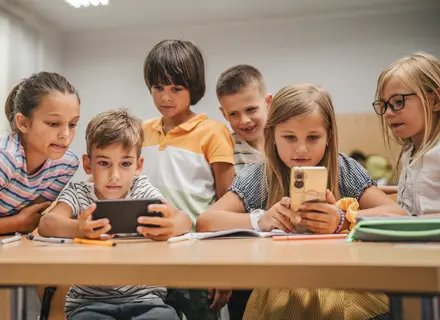School is no place for cellphones: This new message has been the talk of the town in 2024. In the United States, authorities are imposing some of the strictest bans on smartphones and in the words of Jennifer Jolly, Emmy Award-winning consumer tech columnist, educators, lawmakers and even some students are now agreeing to the fact that technology is indeed becoming a constant distraction, taking a toll on academic performance and mental health.
“Cellphones are a drug, and kids are wired to get addicted,” Idaho’s Boise County Sheriff Deputy Dave Gomez told USA Today over the phone.
Gomez has been a school resource officer for the past 11 years and says he has seen the problems with students and smartphones get worse every year.
In July 2024, the Los Angeles Unified School District Board, overseeing approximately 1,000 schools, approved a resolution to create a policy banning student use of cellphones and social media platforms in public schools. This decision joined a growing trend across American districts, states, and cities. Although the policy is set to be implemented in 2025, it will not take effect until then.
Finding the rationale
Recently, US Surgeon General Dr Vivek Murthy called for warning labels to be added to social media platforms, similar to the health warnings that appear on tobacco and alcohol products.
Jennifer Jolly talked about a case from Wilmington, North Carolina, where a person named Leigh Hicks allowed her daughter to use an iPhone just before the sixth grade. Hicks used Apple’s parental controls and set strict ground rules around her daughter’s iPhone. Still, within a year, her daughter, in the words of Hicks, “Was completely and totally consumed by that smartphone and social media, and it absolutely changed who she was. She got maybe like 23 write-ups in school. She would sneak into my room at night and use my face or my finger to unlock the phone in the middle of the night. It was a horrible experience.”
Hicks had to get rid of the phone. Now, her almost 16-year-old daughter is starting 10th grade with a Lively Jitterbug Flip2 phone, a device marketed mainly to senior citizens for simple calls and texts.
Virginia-based first grade teacher Allison Graves also regretted giving her daughter an older-model iPhone just before the seventh grade. Despite her locking down her daughters’ phones, apart from setting Apple screen time limits and turning on content, privacy and app download restrictions, the child managed to have TikTok on it.
Graves eventually replaced the device with a Bark phone built specifically for kids. The phone’s uniqueness lies in the fact that it can be modified with features as kids mature.
Many schools from Seattle to St. Louis are adopting a no-cellphone policy, and several states are also implementing measures to keep phones out of schools. Even states such as New York and California are considering similar policies. As of August 2024, 11 states either restrict cellphones in schools or have policies that encourage schools to do so from the beginning of the school day until the end.
Nearly three-quarters of high school teachers and one-third of middle school teachers in America are now saying that smartphone distractions are becoming a significant problem in their classrooms, according to a Pew Research Centre survey released in June.
Another study released last fall by Common Sense Media shows that 97% of kids use their phones at school. The average student gets about 60 notifications during school hours in a single day and spends 43 minutes, about the same length as a full class period, on their phone.
Extent of the menace
Nearly three-quarters of US high school teachers say smartphones are a major distraction in the classroom, according to a Pew Research poll conducted in November 2023.
“High school teachers are especially likely to see cellphones as problematic. About seven in 10 (72%) say that students being distracted by cellphones is a major problem in their classroom, compared with 33% of middle school teachers and 6% of elementary school teachers,” the survey reported.
As per the Pew report, high school teachers are especially likely to see cellphones as problematic. About seven-in-ten (72%) say that students being distracted by cellphones is a major problem in their classroom, compared with 33% of middle school teachers and 6% of elementary school teachers.
Overall, 82% of American teachers say their school or district has a cellphone policy of some kind. Middle school teachers (94%) are especially likely to say this, followed by elementary (84%) and high school (71%) teachers.
However, as the study covered the views of a few American teenagers (back in 2023), 95% of the respondents said they have access to a smartphone. Even as some policymakers and teachers see downsides to smartphones, these teenagers tend to view the devices as a more positive than negative thing in their lives overall.
“Seven-in-ten teens ages 13 to 17 say there are generally more benefits than harms to people their age using smartphones, while three-in-ten say the opposite. And 45% of teens say smartphones make it easier for people their age to do well in school, compared with 23% who say they make it harder. Another 30% say smartphones don’t affect teens’ success in school,” the report noted.
Hearing out the experts
Jonathan Haidt, social psychologist and author of “The Anxious Generation: How the Great Rewiring of Childhood Is Causing an Epidemic of Mental Illness,” said his research has identified a strong link between smartphone use and declining mental health.
“To the teachers and administrators I spoke with, this wasn’t merely a coincidence. They saw clear links between rising phone addiction and declining mental health, to say nothing of declining academic performance,” Haidt mentioned, as he continued, “A common theme in my conversations with them was: We all hate the phones. Keeping students off of them during class was a constant struggle. Getting students’ attention was harder because they seemed permanently distracted and congenitally distractible.”
In February 2024, British communications regulator Ofcom found nine in 10 youngsters in the United Kingdom own a mobile phone by the time they are 11. The regulator further said more should be done by social media companies and caregivers to protect children from harmful online content.
Daniele Harford-Fox, principal of Guernsey’s Ladies College, located in Guernsey, one of the Channel Islands in the English Channel near the French coast, told the BBC, “I absolutely think mobile phones, in under-16s particularly, should be banned in schools. Social media companies are creating algorithms that are keeping us addicted to our phones and we are seeing this dramatic rise in mental health and wellbeing problems in young people. So for me, there is no question that for eight hours of the day at least I can protect children from that exposure and I am going to do it.”
Harford-Fox added that since controls had been put in place at her college, things took a positive turn, with students experiencing “more play and connection” between themselves.
Liz Coffey, executive principal of the Secondary School Partnership in Guernsey, said the island’s four States-funded high schools have enacted a similar policy.
Dr Carmel Corrigan, Jersey’s Children’s Commissioner, however, is among those who think the time for banning smartphone technology has passed.
She said that there’s a “huge amount of positive things” smart technology can be used for, from improving “safety, educating and forming social contacts”.
Does banning smartphones in schools work?
Marilyn Campbell, professor of early childhood and inclusive education in the Faculty of Education at Queensland University of Technology, and Elizabeth Edwards, associate professor in education at the University of Queensland, Australia, carried out a “scoping review” of published and unpublished global evidence for and against banning mobile phones in schools. The findings were published in March 2024.
The research covered 1,317 articles and reports, including dissertations from master’s and PhD students, written between 2007 (when the smartphone was first introduced) and May 2023. The authors also identified 22 studies that examined schools before and after phone bans. These studies covered schools in approximately 12 countries.
From their initial research, Campbell and Edwards said they found only weak evidence for the benefits of banning smartphones in school.
However, Policy Exchange, a British educational think tank, published a study in May 2024, titled “The Case for a Smartphone Ban in Schools,” a study which reportedly showed a clear correlation between an effective phone ban and better school performance.
Opinions on how to address the impact of smartphones and social media vary considerably. Some oppose an outright ban on using smartphones in schools, saying removing critical communication devices from schools will not address the root of the problem.
“I don’t think bans solve the thing that we’re trying to solve, which is trying to get our kids to understand when it’s appropriate to use phones and when it’s not,” Keri Rodrigues, president of the US-based National Parents Union, told Al Jazeera.
However, Daisy Greenwell, co-founder of Smartphone Free Childhood in the United Kingdom, a parent-led organisation that focuses on the responsible use of smartphones with children, said she backs curbs on smartphone use.
“We feel like childhood is being colonised by Big Tech in a way that we’ve not, as a society, spoken about with each other enough,” Greenwell told Al Jazeera, as she added, “Teachers are telling us the biggest problems that they face in school come from the smartphones and the social side and social problems that it causes amongst the pupils.”
While experts and education sector stakeholders argue that banning smartphones in schools can mitigate distractions and enhance focus, the move may also deprive students of valuable learning resources and essential communication tools.
“School’s the same for 120 years, where kids go nine to three, have long holidays, sit at desks and have to regurgitate what the adults tell them to learn, basically all over the world. We’re blaming kids for falling academic standards, we’re blaming the rise in mental ill health, we’re blaming the rise of cyberbullying. Oh, well, it all must be the fault of the mobile phone,” Marilyn Campbell said.
As per the experts, a balanced approach, involving regulated use and clear guidelines, may be the most effective way to harness the benefits of smartphones while minimising their drawbacks. The general recommendation of Campbell and Edwards, who carried out the scoping review in Australia, was to leave it to individual schools to determine smartphone use and to focus on helping children use smartphones positively.

